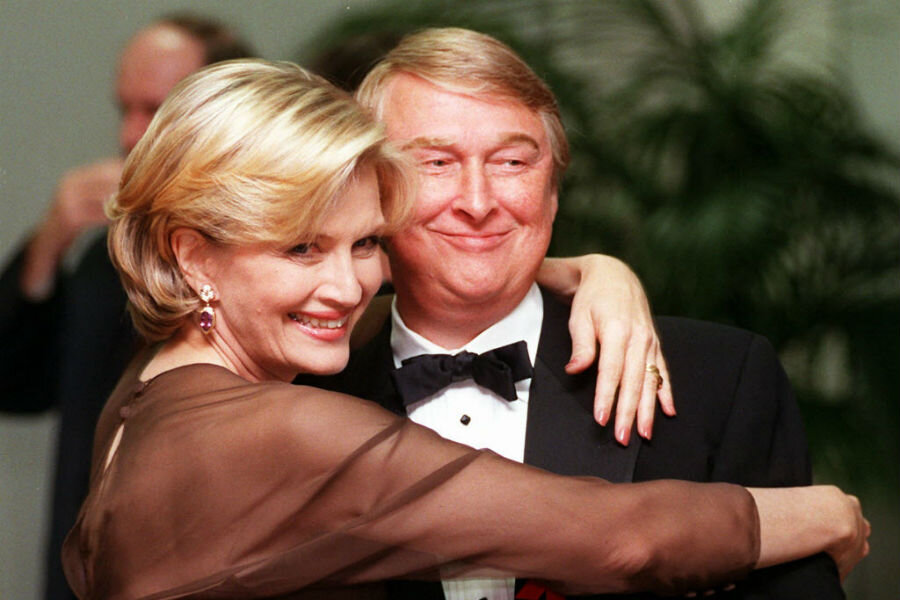Remembering Mike Nichols, fearless director, unparalleled auteur
Loading...
| Los Angeles
Mike Nichols, who died Wednesday, was a fearless director, lauded for his unparalleled ability to "present truly adult themes without compromise" and to seamlessly jump back and forth between film, television, and stage.
“Mike Nichols did not shy away from controversial subjects in his work – really controversial subjects, not subjects around which controversy is manufactured,” says Ron Bishop, professor in the Department of Culture and Communication at Drexel University in Philadelphia. “Folks in my line of work have this argument all the time: Can popular culture and the arts also educate and compellingly illuminate the human condition?"
Mr. Nichols answered that question with a resounding "yes."
Nichols, a Jew, was born in Germany in 1931. He and his family fled the country at the start of World War II. Nichols recalled the day he arrived in the United States in 1939 in a 2012 interview with Entertainment Weekly.
"My father was waiting for us on the dock, and the first thing I saw was a kosher deli and in the neon sign were Hebrew letters. I said to my dad, ‘Is that allowed?’ And he said, ‘Here, it is.’ Unbelievable luck. Undeserved luck. Life-shaming luck.”
Nichols brought that understanding of hardship to his work.
Wheeler Winston Dixon, editor of the Quarterly Review of Film and Video at the University of Nebraska, Lincoln, notes that “Nichols almost single handedly insisted that the screen should be allowed to present truly adult themes without compromise, ending a long period in which the theater could be more frank about life than the movies.”
Dixon also says that everyone wanted to work with Nichols, and at same time he had a superb visual sense. " 'Virginia Woolf' won the Oscar for Haskell Wexler's super black and white camerawork – so that he was a consummate auteur, able to work effectively as both an actor's director as we as being an assured visual stylist."
“Nichols knew how to "open up" a play on the screen,” adds Dixon, “so that it didn't seem artificial – his work with the actors is intimate and real, but he also managed to make his films work in the real world, so the result was never 'stagey' or artificial.”
In short, says Dixon, "Nichols made the jump from stage to screen with such style and grace that he became the model for anyone who might want to follow in his footsteps, but nobody really could do it as well – even Elia Kazan's work in film is more interested in performance than visuals. Nichols could do it all, from the first time out – and brilliantly.”
That versatility earned Nichols the coveted EGOT – four Emmys, a Grammy, an Oscar, and eight Tony Awards, to be exact.
He won his first major award in 1961, when he and Elaine May won the Grammy for Best Comedy Performance for their album "An Evening With Mike Nichols And Elaine May." He won an Oscar in 1967 for directing "The Graduate."
He will be remembered mentioned with the all-time Hollywood greats, observers say.
“Like Orson Welles, to whom he was occasionally compared, Nichols managed not only to work in many different artistic forms (theater, radio, film, television) but also to create masterpieces in those forms. In 'Who's Afraid of Virginia Woolf,' Nichols, a theater director who'd never made a movie, managed to reshape that play in uniquely cinematic ways,” says Robert Thompson, founder of the Bleier Center for Television and Popular Culture at Syracuse University in New York. It was just a year later, notes Thompson, that Nichols “directed one the jewels in the crown of the American cinema, 'The Graduate.' Although he employed many of the same skills in all of his work – a sharp eye, an ability to work with all kinds of actors – he knew the difference between the stage and screen and shaped his material accordingly.”
“The Graduate” made a star of then unknown actor, Dustin Hoffman, the 21-year-old protagonist, a Southern Californian and a track star who sleeps with the wife of his father’s best friend and then falls in love with her daughter.
“There is no piece of casting in the 20th century that I know of that is more courageous than putting me in that part,” Mr. Hoffman, who was nearly 30 when he played Benjamin Braddock, said in an interview in The New Yorker in 2000.
Nichols's creations and his unique talents remained relevant through the decades, helping to translate both serious and humorous material from one medium to another.
He brought Tony Kushner's Pulitzer Prize-winning play "Angels in America" to a national audience with a highly acclaimed 2003 miniseries for HBO.
He directed Neil Simon’s early comedies “Barefoot in the Park” and “The Odd Couple” in the 1960s, the zany Monty Python musical, “Spamalot,” four decades later, and nearly another decade after that, an acclaimed revival of Arthur Miller’s bruising masterpiece, “Death of a Salesman.”
Nichols was married to ABC broadcaster Diane Sawyer.







